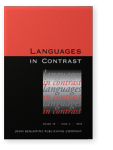Vol. 18:2 (2018) ► pp.207–229
Crossed transposition in a corpus-based study of motion in English and Spanish
The present paper reports on a translation-based teaching-oriented study of the expression of path and manner of motion (Talmy 1972) in English and Spanish. The aim is to explore contrastive differences by analysing translations, with special attention to crossed transposition (Molina and Hurtado Albir 2002), which implies a double shift of part-of-speech from the source text to the target text, and is the expected type of transfer between a satellite-framed language like English and a verb-framed language like Spanish. Two corpora have been used, a monolingual corpus of Children’s Short Stories, the CSS-corpus, and a parallel corpus English-Spanish, P-ACTRES 2.0. The results show a high tendency for implicitation of either path or manner and for compression in the translations into Spanish, whereas crossed transposition is preferred in the translations into English. Also, some pedagogical applications are suggested for including these motion expressions in TEFL to young learners through storytelling.
Article outline
- 1.Introduction
- 2.Theoretical background
- 3.The corpora
- 4.Results and discussion
- 5.Conclusions
- Note
-
References
